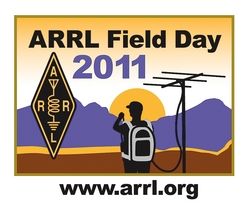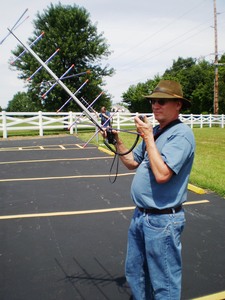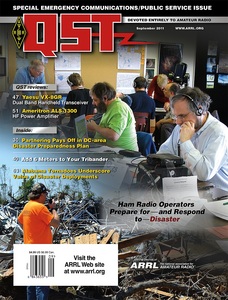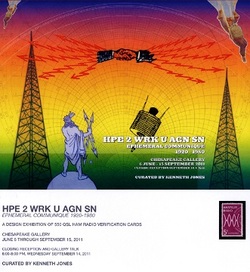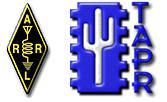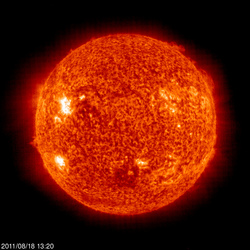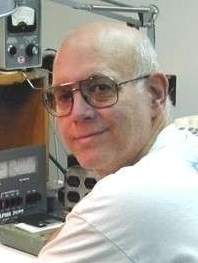 August 18, 2011 John E. Ross, KD8IDJ, Editor
| ||||||||
+ Available on ARRL Audio News + ARRL Field Day: 2011 Field Day Logs Posted
A record 2654 submissions have been received for the 2011 running of ARRL Field Day. According to ARRL Field Day Manager Dan Henderson, N1ND, this is the highest number of entries received for what is one of Amateur Radio's most popular on-the-air operating events. The combined list of Logs Received for Field Day has been posted online. The list includes all logs submitted via the website, as well as those submitted via e-mail and US Mail. Read more here. + Amateur Radio in the Classroom: ARRL Teachers Institute on Wireless Technology Opens Horizon of Learning Opportunities
This summer, the ARRL offered five sessions of the Teachers Institute on Wireless Technology (TI). Veteran instructors Miguel Enriquez, KD7RPP, and Nathan McCray, K9CPO -- along with new Instructors Tommy Gober, N5DUX, and Matt Severin, N8MS -- led the instruction. A total of 55 educators from 24 states, ranging from elementary teachers to university PhDs, took part in the 2011 TIs. The first TI session of 2011 was held at Desert Ridge Middle School in Albuquerque, New Mexico, and was hosted by Diane Nihart, KE5UHB, a 2010 TI graduate. Other sessions took place at Parallax, Inc's corporate office in Rocklin, California (Parallax provides the robotics equipment for each TI session); at Mohawk Valley Community College in Utica, New York -- hosted by Bob Decker, AA2CU; and at ARRL Headquarters. The Dayton Amateur Radio Association hosted the TI-2 seminar, Space in the Classroom. The TI-2 curriculum focuses on the nuts and bolts of setting up and operating a satellite ground station. While TI participants do not need to have an Amateur Radio license to attend a session, TI-2 participants must have at least a Technician class license and have already attended a TI session. Read more here. + ARRL and California Researchers Team Up to End 12 Meter Interference After the resolution of the recent 60 meter Coastal Ocean Dynamics Applications Radar (CODAR) situation on the East Coast, the ARRL noted an earlier report by John Terrell, N6LN, of Palos Verdes, California. Terrell described CODAR activity on the 12 meter band, from 24.93 to 25.058 MHz. Since it appeared likely it was originating on the West Coast -- possibly near Orange Section Official Observer Coordinator Dan Welch, W6DFW -- ARRL Field and Regulatory Correspondent Chuck Skolaut, K0BOG, contacted Welch for assistance. Read more here. + Check Out the September Issue of QST The September issue of QST is jam-packed with all sorts of things that today's Amateur Radio operator needs. This issue focuses on Emergency Communications and Public Service, activities that many hams enjoy. From product reviews to experiments to contesting, this issue of QST has something for just about everyone.
Victor Cid, W3CID, and Andrew Mitz, WA3LTJ, know that radio amateurs have a long history of tinkering, of taking something and adjusting it to their purposes. These two hams -- who work at the National Institutes of Health in Washington, DC -- did just that when they developed a unique way to link a group of Maryland hospitals during major disasters via Amateur Radio. Find out how they did it in their article "Optimizing Amateur Radio Resources for Major Disasters." When your ARES® group is activated during an emergency, you know to grab your go-kit. Geoff Haines, N1GY, took this idea a bit further with his article "An Emergency Radio Package - or The Radio in a Box II." Haines developed a box to hold a dual-band VHF/UHF radio, a battery and paperwork using only materials and equipment he already had on hand. David Gillespie, W4LHQ, looks back at the devastating Alabama tornadoes earlier this year in his article "Alabama Slammer." Gillespie recounts that thanks to the the training hams had before the storm -- as well as the experiences they brought with them from past disaster deployments -- was crucial to providing top-notch communications support to the area served agencies. Speaking of practice, it's time to get ready for the 2011 Simulated Emergency Test (SET), set for October 1-2. ARRL Field Organization Supervisor Steve Ewald, NV1X, takes a look at this annual event that tests emergency operating skills and the readiness of communications equipment and accessories in an emergency-like deployment. QST Contributing Editor Howard Robins, W1HSR, takes a look at the Yaesu VX-8GR dual-band handheld transceiver in this month's Product Review. He says that this radio "incorporates GPS and a slew of features into a rugged, compact package. With so many features in a small package, it will be most appropriate for advanced amateurs wanting to explore and master APRS and GPS technology." QST Contributing Editor Phil Salas, AD5X, also checks out the Ameritron ALS-1300 HF power amplifier. He says this amplifier "delivers the goods and provides a good value for those interested in a solid state near-legal-limit linear power amplifier for 160-10 meters." Ward Silver, N0AX, delivers the results of the 2011 ARRL International DX Phone Contest. With the bands wide open during the contest, Silver noted that "more butts in more chairs [meant] a 24 percent increase in QSOs reported by US and Canadian stations. There were more single-band logs than ever this year and the big increase was -- no surprise -- 10 meters, which went from 13 logs submitted in 2010 to 60 in 2011." Of course, there are the usual columns you know and expect in the September QST: Happenings, Hints & Kinks, The Doctor Is IN, How's DX, Technical Correspondence, Vintage Radio and more. Look for your September issue in your mailbox. QST is the official journal of ARRL, the national association for Amateur Radio. QST is just one of the many benefits of ARRL membership. To join or renew your ARRL membership, please see the ARRL web page. + QSL Card Exhibit in Maryland Through September 15 HPE 2 WRK U AGN SN: Ephemeral Communiqué 1920-1980 -- a design exhibit of more than 550 QSL cards -- will be on view until September 15, 2011 at the Chesapeake Gallery on the campus of Harford Community College in Bel Air, Maryland. It is curated by Harford CC Professor of Art and Design Kenneth Jones. Jones will present a talk at the closing reception September 14 from 6-8 PM.
"In an age of communicating wirelessly with avatars, tweets and friending through Facebook. QSL cards are sophisticated communication devices that reconnect two people to the past," Jones told the ARRL. "Today, the pace of communication is so much faster, and the memory of that communication may be stored or in most cases hidden in histories, caches and the recesses of hard drives and servers. The act and art of QSLing is an act of respect, unity and friendship." Jones said that he "rediscovered" his grandfather's QSL cards a few years ago: "When I opened [the box], I was overwhelmed by the aroma contained in the contents. The box was full of items from my grandfather (he passed in 1987) and included QSL cards, which transported me to the shack he used which was part of his kitchen. I remembered the big antenna on top of his little home, and how he would let me turn the dial to change its direction. The cards in the box sparked my interest in their design and history, so I began to research and collect them. After collecting about 10,000 of them, I started to think about writing a book about the design history of the cards and applied for a sabbatical, which I was awarded and then took in the fall of 2010." HPE 2 WRK U AGN SN is a design exhibition of more than 550 QSL cards from the Golden Age of Amateur Radio (1920-1980), presented and arranged by style. Jones selected the cards from the more than 10,000 in his collection. Read more here. + Amateur Radio Technology: 30th Annual ARRL/TAPR Digital Communications Conference Set for September
The Four Points Sheraton Hotel at Baltimore Washington International Airport is home base for the 30th annual ARRL/TAPR Digital Communications Conference, September 16-18. This conference is an international forum for radio amateurs to meet and publish their work, as well as present new ideas and techniques. Presenters and attendees will have the opportunity to exchange ideas and learn about recent hardware and software advances, theories, experimental results and practical applications. Read more here. Solar Update
Tad "The warmth of the Sun is in your smile" Cook, K7RA, reports: Solar activity was down again this week -- the sunspot number on Sunday went all the way to 0 for the first time since January 27, which was 29 weeks ago. The average daily sunspot numbers declined nearly 50 points, to 25.6, while the average daily solar flux was down nearly 16 points to 88.5. The latest prediction from NOAA/USAF on August 17 has the solar flux at 98 on August 18, 100 on August 19-21, 105 on August 22-24, then 110, 115, and 115 on August 25-27, and back to 110 on August 28-31. The predicted planetary A index is 5 on August 18-20, 8 on August 21, 5 on August 22-25, 15, 10 and 8 on August 26-28, and 5 again on August 29-31. Thanks to Max White, M0VNG, of Worcester, England, for sending along this story from NASA, "Solar Flares: What Does It Take to Be X-class?" Look for more information on the ARRL website on Friday, August 19. For more information concerning radio propagation, visit the ARRL Technical Information Service Propagation page. This week's "Tad Cookism" is brought to you by The Bangles' Waiting for You. + Silent Key: Tom Hammond, N0SS
Tom Hammond, N0SS, of Lohman, Missouri, passed away August 4 from cancer. He was 67. Hammond was the first and only Life Member of the Kansas City DX Club, playing an invaluable role in the club for more than three decades, creating his world famous CW pileup files each year for the annual CW Pileup Competition at the Dayton Hamvention. Read more here. This Week on the Radio This week:
Next week:
All dates, unless otherwise stated, are UTC. See the ARRL Contest Branch page, the ARRL Contest Update and the WA7BNM Contest Calendar for more information. Looking for a Special Event station? Be sure to check out the ARRL Special Event Stations Web page. Upcoming ARRL Section, State and Division Conventions and Events
To find a convention or hamfest near you, click here. ARRL -- Your One-Stop Resource for Amateur Radio News and Information Join or Renew Today! ARRL membership includes QST, Amateur Radio's most popular and informative journal, delivered to your mailbox each month. Subscribe to NCJ -- the National Contest Journal. Published bi-monthly, features articles by top contesters, letters, hints, statistics, scores, NA Sprint and QSO Parties. Subscribe to QEX -- A Forum for Communications Experimenters. Published bi-monthly, features technical articles, construction projects, columns and other items of interest to radio amateurs and communications professionals. Free of charge to ARRL members: Subscribe to the ARES E-Letter (monthly public service and emergency communications news), the ARRL Contest Update (bi-weekly contest newsletter), Division and Section news alerts -- and much more! Find us on Facebook. Follow us on Twitter. ARRL offers a wide array of products to enhance your enjoyment of Amateur Radio Donate to the fund of your choice -- support programs not funded by member dues! Click here to advertise in this newsletter. | ||||||||
